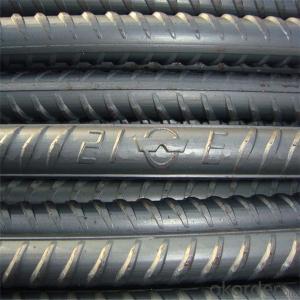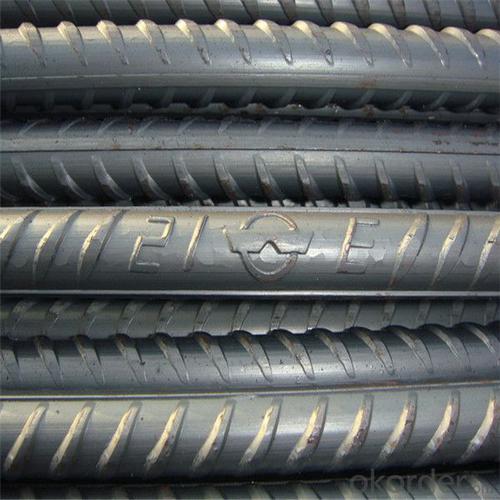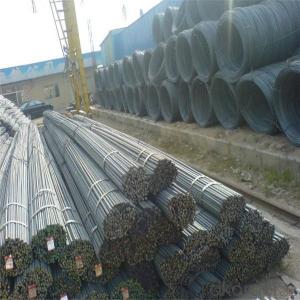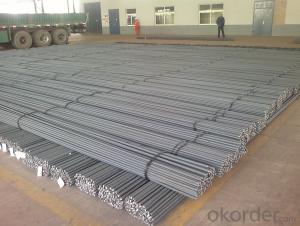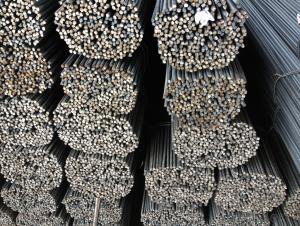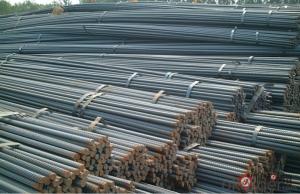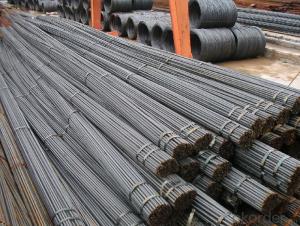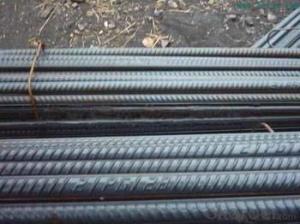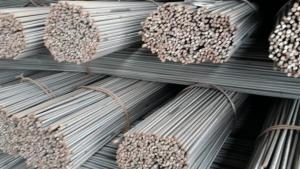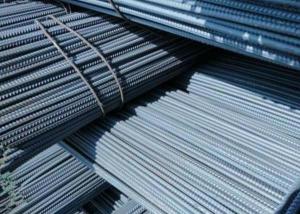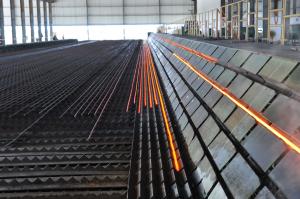Iron bar from China steel mill 6-50 mm for building
- Loading Port:
- Shanghai
- Payment Terms:
- TT OR LC
- Min Order Qty:
- 1000 m.t.
- Supply Capability:
- 19863 m.t./month
OKorder Service Pledge
OKorder Financial Service
You Might Also Like
Specification
Common rebar is made of unfinished steel, making it susceptible to rusting. As rust takes up
greater volume than the iron or steel from which it was formed, it causes severe internal pressure
on the surrounding concrete, leading to cracking, spalling, and ultimately, structural failure. This is
a particular problem where the concrete is exposed to salt water, as in bridges built in areas where
salt is applied to roadways in winter, or in marine applications. Epoxy-coated rebar or stainless steel
rebar may be employed in these situations at greater initial expense, but significantly lower expense
over the service life of the project. Fiber-reinforced polymer rebar is now also being used in high-corrosion
environments
Our Advantage:
High quality steel products from 1 class mills in China
Reasonable price
Professionalism of the products
On-time delivery
Complete documents and certificates
Sincere service to meet our clients' requirements
Product Description :
Chemical composition (%): | Steel | C | Si | Mn | P | S | Ceq | ||||
HRB335 |
0.25 |
0.80 |
1.60 |
0.045 |
0.045 | 0.52 | |||||
HRB400 | 0.54 | ||||||||||
HRB500 | 0.55 | ||||||||||
Mechanical properties | Steel | Rel/ MPa | Rm/ MPa | A/ % | Agt/ % | ||||||
≥ | |||||||||||
HRB335 | 335 | 455 | 17 |
7.5 | |||||||
HRB400 | 400 | 540 | 16 | ||||||||
HRB500 | 500 | 630 | 15 | ||||||||
Package: | Standard export packing or as customer's request | ||||||||||
Application: | Construction, building, bridge, road. ect | ||||||||||
Payment terms | 1).100% irrevocable L/C at sight. | ||||||||||
Delivery time | 15-30 days after receipt of L/C or deposit by T/T | ||||||||||
Features
1、Pure steel quality, stable chemical contents, small tolerance.
2、Constant Quality, good drawing performance.
3、High dimension accuracy degree, accuracy degree of Level C up to 80%, smooth surface, less scale, easy to be pickled.
4、Automatic bundling with 4 lines by Machine in tidy and good looks
5、Big high quality percentage, small coil percentage, and heavy coil weight for Hard Coil.
6、High sorbitizing percentage.


Packing:
In bundles, each bundle weight 3.5 tons. Load by container or by bulk verssel.
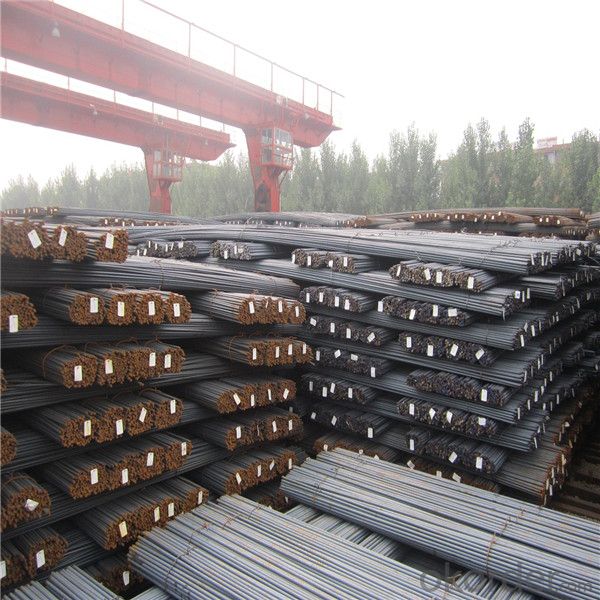
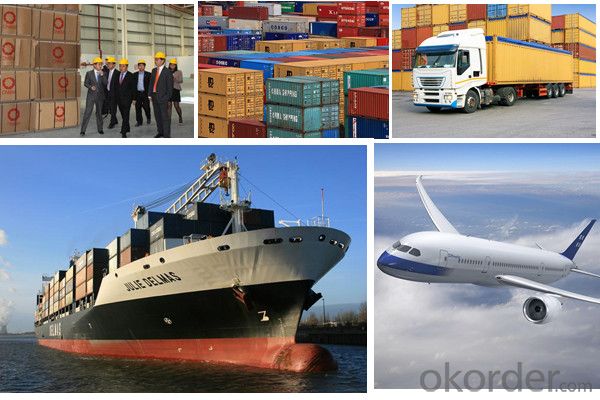
Our service
(1) We cooperate with famous factories with advanced equipment and well trained workers.
(2) We can provide factory price with trading company service.
(3) We continuously work on the improvement of our processes, guaranteeing consistently high standards
of quality to keep none compensation.
(4) We guarantee 24 hours response and 48 hours solution providing service.
(5) We accept small order quantity before formal cooperation.
(6) We deliver the agreed quality at the agreed time, reacting to changes in customer wishes in a flexible way.
(7) Due to our volume and selling power, we have excellent freight rates with shipping lines.
(8) We strive to always be fair and honest in our dealings with customers.
(9) We strive to work together with customers to achieve much more than we can achieve alone.
(10) Through our passion and commitment we aim to be a market leader in all our key markets. To maintain
our position as market leader we must continue to add value in all that we do.
FAQ:
1.Q: What's your MOQ(minimum order quantity)?
A: One full container, mixed acceptable .
2. Q: What's your packing methods?
A: Packed in bundle or bulk ..
3. Q: How can I buy CNBM products in my country?
A:Please send us an inquiry or email ,we will reply to you if there is distributor in your country
4. Q: Can we visit your factory?
A: Warmly welcome. Once we have your schedule, we will arrange the professional sales team to follow up your case.
5. Q: How long does it take to get the product if i place an order?
A:With the process of your requirements,we will pack and deliver in 3-7 days. If it is by sea shipment,it will take 15-45 days depending on different locations
- Q: What are the different types of steel rebars used in building construction?
- There are several different types of steel rebars used in building construction, each with unique properties and applications. Some of the common types include: 1. Mild Steel Rebars: These rebars are also known as black bars and are the most commonly used type. They have low carbon content and are suitable for general construction purposes. 2. High Strength Deformed (HSD) Bars: HSD bars are heat-treated rebars with a higher yield strength than mild steel rebars. They have a ribbed surface that provides better bonding with concrete, making them ideal for structures that require higher load-bearing capacity. 3. Epoxy-Coated Rebars: These rebars are coated with epoxy resin to protect against corrosion. Epoxy coating prevents the steel from coming into direct contact with moisture and chemicals, thereby increasing the lifespan of the structure. 4. Galvanized Rebars: Galvanized rebars are coated with a layer of zinc to protect against rust and corrosion. The zinc coating acts as a sacrificial layer, preventing the steel from corroding even if the coating gets damaged. 5. Carbon Steel Rebars: Carbon steel rebars are made from carbon steel and have higher tensile strength than mild steel rebars. They are commonly used in high-rise buildings and heavy construction projects. 6. Stainless Steel Rebars: Stainless steel rebars are highly resistant to corrosion and are used in structures exposed to harsh environments or chemicals. They are more expensive than other types of rebars but offer superior durability. 7. European Rebars (Euro Rebars): Euro rebars are manufactured according to European standards and have specific markings to denote their grade and properties. They are widely used in European construction projects. The choice of rebar type depends on factors such as the intended use of the structure, environmental conditions, and the required strength. It is crucial to select the appropriate type of rebar to ensure the longevity and stability of the building.
- Q: What are the guidelines for the proper cover thickness of steel rebars?
- The guidelines for the proper cover thickness of steel rebars are established to ensure the structural integrity and durability of reinforced concrete structures. The cover thickness refers to the distance between the outer surface of the rebar and the edge or surface of the concrete. The specific guidelines for cover thickness may vary depending on the design requirements, environmental conditions, and the intended use of the structure. However, there are generally accepted minimum cover thickness values provided by various international building codes and standards. The primary purpose of having an adequate cover thickness is to protect the steel rebar from corrosion caused by environmental factors such as moisture, carbonation, and chloride ingress. Corrosion can significantly weaken the rebars, compromising the structural integrity of the reinforced concrete. The recommended minimum cover thickness for steel rebars is typically determined based on the exposure conditions. For instance, in normal environmental conditions, a minimum cover thickness of 25mm to 40mm is often specified. In more aggressive environments, such as coastal areas with high chloride content or structures in contact with soil, a greater cover thickness of 50mm or more may be required. It is crucial to follow these guidelines to ensure the longevity and safety of the structure. Inadequate cover thickness can lead to accelerated corrosion of the rebars, resulting in reduced load-bearing capacity, cracking, and ultimately structural failure. Therefore, it is essential to consult the applicable building codes, standards, and design professionals to determine the appropriate cover thickness for steel rebars in a specific construction project.
- Q: How do steel rebars affect the overall construction cost of commercial buildings?
- The overall construction cost of commercial buildings can be significantly affected by steel rebars. These rebars, commonly used to reinforce concrete structures, play a vital role in guaranteeing the building's strength and durability. To begin with, the cost of steel rebars can directly impact the construction budget. Their price varies depending on market conditions and availability, and since they are an essential component in construction, their cost can directly affect the project's expenses. Additionally, the installation of steel rebars adds to the construction cost by requiring skilled labor and specialized equipment. Skilled ironworkers are necessary to accurately place the rebars according to the structural design. The labor cost associated with this skilled work can constitute a significant portion of the overall construction budget. Furthermore, the cost is also influenced by the quantity and density of steel rebars used in the construction. The structural engineer determines the necessary amount and spacing of rebars based on the building's design and load-bearing capacities. In certain cases, more rebars are needed to meet specific safety standards or withstand higher levels of stress. This increased quantity of steel rebars inevitably leads to higher material and labor costs. However, it is essential to note that the use of steel rebars is indispensable in commercial buildings to ensure structural integrity and safety. Although they may contribute to the overall cost, their benefits outweigh the expenses. Steel rebars reinforce concrete, enhancing its tensile strength and ability to withstand external forces like earthquakes, wind, and heavy loads. Ultimately, this results in a longer lifespan for the building and reduces the likelihood of expensive repairs or structural failures in the future. In conclusion, the cost of steel rebars impacts the overall construction cost of commercial buildings due to the cost of the rebars themselves, the labor required for installation, and the quantity needed based on the structural design. Nevertheless, the use of steel rebars is crucial to guarantee the strength and durability of the building, reduce long-term maintenance costs, and ensure the safety of occupants.
- Q: Can steel rebars be used in structures with high humidity levels?
- Yes, steel rebars can be used in structures with high humidity levels. However, it is important to ensure proper corrosion protection measures are in place to prevent rusting and deterioration of the rebars over time. This can include using corrosion-resistant coatings or stainless steel rebars, as well as proper concrete cover to create a barrier between the rebar and the surrounding environment. Regular maintenance and inspections are also necessary to monitor and address any signs of corrosion.
- Q: Can steel rebars be used in tunneling and mining operations?
- Yes, steel rebars can be used in tunneling and mining operations. Rebars, which are steel bars commonly used to reinforce concrete structures, can also be employed in underground construction projects such as tunnels and mines. These steel bars provide additional strength and stability to the structures in these environments, ensuring durability and safety. In tunneling projects, rebars are often embedded in shotcrete or concrete linings to enhance the structural integrity of the tunnel walls and prevent collapse. Similarly, in mining operations, rebars are used to reinforce the roofs, walls, and support structures within the mine, safeguarding against potential hazards such as rockfalls and cave-ins. The use of steel rebars in tunneling and mining operations is crucial for maintaining the integrity and stability of these underground structures.
- Q: How do steel rebars affect the overall sustainability of bridge constructions?
- The overall sustainability of bridge constructions is greatly improved by the inclusion of steel rebars. Firstly, steel rebars play a crucial role in enhancing the longevity and durability of bridges. They reinforce concrete structures, ensuring that tensile and compressive forces are evenly distributed and minimizing the risk of cracks and structural failure. This results in a longer functional lifespan for the bridge, reducing the need for frequent repairs or replacements and ultimately decreasing material consumption and waste generation. Furthermore, the sustainability of bridge constructions is further enhanced by the high recyclability of steel rebars. Once a bridge reaches the end of its life cycle, the steel rebars can be easily removed and recycled. This reduces the demand for new steel production, conserving natural resources and reducing carbon emissions associated with manufacturing processes. Additionally, the recycling of steel rebars helps mitigate the environmental impacts of mining and extraction activities. In addition, the use of steel rebars enables the design of lighter and more efficient bridge structures. Steel is known for its high strength-to-weight ratio, allowing for the creation of slender and visually appealing bridge designs. By reducing the weight of the bridge, less material is required for construction, resulting in lower energy consumption and carbon emissions during manufacturing, transportation, and construction phases. Furthermore, lighter bridge structures place less strain on the supporting foundation, reducing the need for costly reinforcement measures. In conclusion, the inclusion of steel rebars positively impacts the overall sustainability of bridge constructions in various ways. They enhance durability, reduce the need for repairs or replacements, and minimize waste generation. The recyclability of steel rebars helps conserve natural resources, reduce carbon emissions, and mitigate environmental impacts. Additionally, the use of steel rebars allows for the design of lighter and more efficient bridge structures, resulting in lower energy consumption and associated carbon emissions.
- Q: How are steel rebars used in the construction of wastewater treatment plants?
- Steel rebars are used in the construction of wastewater treatment plants to reinforce the concrete structures, such as tanks and basins, that are essential for storing and treating wastewater. The rebars provide strength and stability to these structures, ensuring they can withstand the weight of the water and the various chemicals used in the treatment process. Additionally, the rebars help to prevent cracking and structural failure, ensuring the longevity and reliability of the wastewater treatment plant.
- Q: Can steel rebars be used in parking garage construction?
- Yes, steel rebars can indeed be used in parking garage construction. Steel rebars are commonly used as reinforcement in concrete structures, including parking garages, to enhance their strength and durability. The rebars help to reinforce the concrete and prevent cracking or collapsing under heavy loads, making them an essential component in parking garage construction.
- Q: How do steel rebars prevent cracks in concrete?
- Steel rebars prevent cracks in concrete by providing reinforcement and increasing the tensile strength of the concrete. Concrete is strong in compression but weak in tension, meaning it can withstand forces that squeeze or compress it, but is prone to cracking when subjected to tension or pulling forces. When steel rebars are embedded within the concrete, they act as a framework or skeleton, distributing the tensile forces throughout the structure. As a result, the rebars absorb the tension, preventing the concrete from cracking and failing under the applied load. The rebars also help to control the size and width of any cracks that may occur. By confining the cracks to a limited area around the rebars, they prevent the cracks from propagating and spreading throughout the entire concrete structure. Additionally, the presence of rebars can also help to prevent cracks from forming in the first place, as they reinforce the concrete and enhance its overall durability. In summary, steel rebars play a crucial role in preventing cracks in concrete by increasing its tensile strength, absorbing tension, and controlling the propagation of cracks. This reinforcement ensures the structural integrity and longevity of concrete structures, preventing potential failures and ensuring their safety.
- Q: What is the process of galvanizing steel rebars?
- Galvanizing steel rebars is a process that involves applying a protective layer of zinc to the surface of the steel rebar to prevent corrosion and extend its lifespan. The process typically involves the following steps: 1. Surface Preparation: The steel rebars are thoroughly cleaned to remove any dirt, oil, or scale on the surface. This is typically done by using a combination of chemical cleaning agents and mechanical methods such as sandblasting or shot blasting. 2. Pickling: After cleaning, the rebars are immersed in a pickling solution, usually a mixture of hydrochloric acid and water. This solution removes any remaining impurities or oxides from the surface of the rebars. 3. Fluxing: The pickled rebars are then rinsed to remove any residual acid and are immersed in a flux solution. The flux solution helps to remove any remaining oxides and ensures proper adhesion of the zinc coating. 4. Galvanizing: The fluxed rebars are then dipped into a bath of molten zinc. The temperature of the zinc bath is typically maintained between 815 to 850 degrees Fahrenheit (435 to 455 degrees Celsius). The rebars are carefully immersed and then slowly withdrawn to allow excess zinc to drain off. 5. Quenching: After galvanizing, the rebars may be quenched in a specialized solution to cool them rapidly and stabilize the zinc coating. This step helps to prevent the formation of excessive zinc oxide on the surface. 6. Inspection: Once the galvanized rebars have cooled, they undergo a thorough inspection to ensure the quality of the coating. Visual inspection, thickness measurement, and adhesion tests are commonly conducted to assess the zinc coating's integrity. Overall, the galvanizing process provides a durable and effective protective coating for steel rebars, making them resistant to corrosion and extending their lifespan in various applications such as construction, reinforcement, and infrastructure projects.
Send your message to us
Iron bar from China steel mill 6-50 mm for building
- Loading Port:
- Shanghai
- Payment Terms:
- TT OR LC
- Min Order Qty:
- 1000 m.t.
- Supply Capability:
- 19863 m.t./month
OKorder Service Pledge
OKorder Financial Service
Similar products
Hot products
Hot Searches
Related keywords
